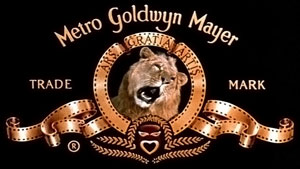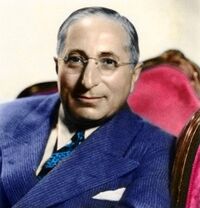Metro-Goldwyn-Mayer
“There are more stars here than in the heavens.”
“Yes, too bad you burned them all out.”
Metro-Goldwyn-Mayer (MGM) is considered the Cadillac of film studios, that was once three struggling studios who merged into one. Their first motto was "Pedere gratia pedere" which meant "Fart for fart's sake" in Latin, since their mascot Leo the Lion initially farted instead of roaring, then they switched over to the motto "Ars gratia artis" ("Art for art's sake"), which sounded cooler.
1916–24: Before MGM[edit]
Metro Studios was formed in 1916 after the success of Birth of a Nation (hey, it was the 1910s) and they found out you can do a lot with special effects. Studio founder Joe Metro then attempted to make an epic film called Civil War, but it flopped big time. So Metro resorted to making a few pornographic films for the next eight years, making it the most successful porn studio of its time.
Goldwyn Studios was also formed in 1916 by Samuel Goldwyn, who also had an interest in making movies after watching Birth of a Nation. He made an epic movie in 1916 called The Count of Monte Cristo and that film too flopped. So Goldwyn made a few safety films for the next eight years, making it the most successful safety film studio of its time.
Mayer Studios was also formed in 1916 by Louis B. Mayer who — you guessed it — watched Birth of a Nation since he then owned the rights to show it in New England. He made an epic movie in 1916 called Titanic starring Sarah Bernhardt and Rudy Valentino and — you guessed it — it flopped. But Mayer didn't give up and instead made a deal with Lowes, who saw that vaudeville was dying and needed ideas for his studios. Mayer asked him to have films shown at those studios rather than blackface singers. And in those eight years, Mayer profited with movie theaters rather than his studio, which made sports movies that did as well.
1924–29: Formation of MGM, early success[edit]
In 1924, Louis B. Mayer learned that the movies being screened at his theaters were made by Metro and Goldwyn. He saw that they sucked, so he got a train ticket to Hollywood, where he would attempt to convince Metro and Goldwyn to make actual movies rather than shit. Mayer, who saw his studio make a few good films, talked to Metro and Goldwyn to either merge with him and make good movies, or make their own crappy movies and eventually go bankrupt. Metro and Goldwyn saw that their films were losing their novelty, so they merged their studios and formed MGM. Goldwyn (the Man) had already left Goldwyn (the Studio) so he wasn't included in the deal. He returned to the bullion business and changed his name to Auric Goldfinger.
The first movie produced by MGM was He Who Gets Silly-Slapped starring Lon Chaney and it was a success. Their first epic movie was Ben Hur in 1925 and it would bring MGM stars that the Heavens would never see; even Jesus would try out for a few movies.
1929–39: Depression success[edit]
In the late 1920s and 1930s, MGM would go through the Great Depression by buying failed studios, acquiring people like The Barrymores and Laurel and Hardy, and having the first talkie called Kick-Ass Movie, which was about a farmer who kicks an ass because it was stubborn as a mule. They also had great success through making movies based on books and buying the rights to show plays of Shakespearean drama and Oscar Wilde. In 1932, Grand Hotel would win an Oscar for Best Damn Picture Ever Period, which Kick-Ass Movie also won in 1929. Throughout the decade, MGM would make the Oscars for almost every category and wouldn't leave empty-handed, even having some of their own films compete against each other.
In that decade, MGM hired Hanna-Barbera when they were just William Hanna and Joseph Barbera, to produce cartoons for the studio. Initially Mayer considered hiring Walt Disney, but decided against it after hearing rumors that Disney was a Jew hater, since Mayer was himself a Jew. During this time Hanna-Barbera made a few cartoons for MGM that no one really knows or cares about. MGM hired also the Marx Brothers on the condition that they dump Zeppo, since they felt he was not funny and just stupid.
The movies that MGM made this decade include A Night at the Opera, A Day at the Races, San Francisco, Mutiny on the Bounty, Gone with the Wind, The Wizard of Oz, Ninotchka, The Great Ziegfeld, Goodbye, Mr. Chips, and Tarzan movies.
1939–45: Wartime success, Tom and Jerry[edit]
In 1940, Hanna-Barbera created the cartoon cat-and-mouse duo Jasper and Jinx. Initial audience reactions were ambivalent, but quickly shot up when the duo was renamed Tom and Jerry, who went on to star in hundreds of cartoons. The Tom and Jerry shorts won critical acclaim and earned numerous awards and major box office bank for MGM, and Hanna-Barbera had found their calling with the best cartoon duo of all-time.
MGM at the time would weed-out their stars who didn't have any success, like Joan Crawford and The Barrymores; actors who survived this purge included Clark Gable, Frank Sinatra, and Judy Garland. They would also make 25 films a year rather than 50, despite making a ton of money. However, MGM would make money on musicals like Anchors Aweigh, Meet Me in St. Louis, and The Harvey Girls to name a few. MGM also made a deal with the New York Yankees to produce movies about their franchise, since baseball is a national pastime. MGM's biggest success in this period was their World War II movies, such as Tarzan Conquers the Nazis, Fashy Fashionable Fashistas, Hiroshima Hijinks, and The Yankee-Doodle Mouse.
1945–66: Downfall[edit]
Unfortunately, once the war was over, MGM fell very hard. In 1950, Metro departed from MGM while filming An American in Paris for a better job at 20th Century Fox, and Goldwyn left to make movies for United Artists in 1952 while filming Singing in the Rain (either Gene Kelly was needy or people left MGM while making a movie that he was in). At this time, MGM became the Packard of movie studios: luxurious, but dying. In 1954, when viewers began watching TV at an increasing rate, Mayer had to let go of Lowes Theaters. People insisted that MGM go into the TV business, but Mayer hated TV, so he instead let go of his big stars, including Hanna-Barbera, Gene Kelly, and Frank Sinatra, shortly before passing away in 1957 (karma?).
Sinatra suggested that MGM burn their studios down since TV now dominated the industry, but they refused. Instead they remade Ben-Hur, which temporarily helped MGM recover, and Gigi starring Maurice Chavalier. MGM then remade their other classics but not the ones that won an Oscar since they weren't to be touched. Their last epic films, such as How the West Was Won and Doctor Zhivago, would try and help MGM keep their head above water, as well as Gene Deitch's and Chuck Jones's psychedelic reincarnations of Tom and Jerry which, while nowhere near as funny or good as the Hanna-Barbera versions, cost only a fraction of H-B's budget to produce and made even bigger bucks for the studio.
1966–2004: The Canadians Take Over, catalog buyouts[edit]
In 1966, a posse of Canadians purchased MGM, and in 1969, they moved MGM's headquarters from Hollywood to Las Vegas and built it around the hotel named after the studio. By that time, the Canadians were focused more on making money with the casino and hotel rather than with movies, severely downsizing MGM's film production which caused them to go belly-up. Notable exceptions to the rule at this time included The Split, which was the first film to be rated R, the Stanley Kubrick acid trip 2001: A Space Odyssey, and the legendary blaxploitation film Shaft.
In 1981, the Canadians bought the rights to United Artists's movie catalog, after they went belly-up with Heaven's Gate.
In 1986, after becoming bored with their own library and watching all their movies made prior to 1986, MGM sold their movie rights to Ted Turner, believing he would have better use for them. Today, all the MGM movies, the Tom and Jerry cartoons, and other bits and pieces that were once part of the MGM library are now owned by Ted Turner; Turner has many MGM classic films colorized and/or sent to the Moon, which itself is then to be colorized.
In 1997, MGM bought the rights to Orion's film library after they went bankrupt, which included the famous James Bond movies and some other films that weren't important. However, even with James Bond, plus a few other good movies like Thelma and Louise and Benny and Joon, MGM was probably good as dead.
2004–present: The Japanese Take Over[edit]
After being saddled with debt and irresponsible business decisions, MGM was acquired by Sony in 2004, so that they could get their movies that weren't owned by Ted Turner on the PlayStation. Sony also had half-ownership of Disney until 2000, when they heard that Disney was owned by Jews, then Disney ceased to work with them because Jews are known to fear the samurai.
| Film world: | Academy Awards ♦ AFI (American Film Institute) ♦ Bollywood ♦ Film colorization ♦ Golden Raspberry Awards ♦ Hays Code ♦ Horny Awards ♦ Internet Movie Database ♦ Lens flare ♦ Roger Ebert ♦ Screenwriting ♦ Gene Shalit ♦ UnReviews |
| Studios: | 20th Century Fox ♦ Disney ♦ DreamWorks ♦ MGM ♦ Paramount ♦ Pixar ♦ Sony Pictures ♦ United Artists |
| Narrators: | David Attenborough ♦ Morgan Freeman ♦ Movie Trailer Announcer Guy |
| Types: | Albanian interpretationalist cinema ♦ B-movie ♦ Cult film ♦ Film noir ♦ Independent film ♦ Parody film ♦ Sequel ♦ Snuff film ♦ Western |



